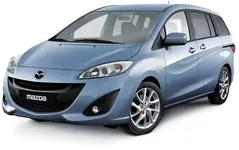It would need to be a 6-gear transmission, the 5-gear revs too high at highway speeds.
As long as the engine is *designed* for high revs, there's nothing inherently wrong with high revs. Americans have bought the GM line for so many years that they believe lower revs are inherently better, but that's simply not true. A smaller engine, running at higher revs, typically has a larger percentage of its power available to it instantaneously; often a smaller-displacement engine at higher revs can generate more horsepower than a larger-displacement engine at lower revs, even while consuming less fuel. A smaller engine at higher revs is less likely to need to downshift to pass, will have better engine braking capability if needed, and will increase the driver's feel for what the engine is doing.
If badly designed, an engine will wear out faster at higher revs, but given that Japanese cars have always typically tended to have higher HP output per displacement and hence tended to run at higher revs and STILL outlive most larger American cars' engines (so much so that they have a reputation for it), it's hard to argue that in practice smaller engines running at higher revs are a bad formula.
Personally, I hate the lackadaisical feeling of a low-power V6 at low revs; I love the snappy, responsive handling of a high-power I-4 at high revs. A small engine at low revs doesn't generate enough power, so it's either small engine at high revs, or large engine at low revs. I ride an air-cooled Triumph Bonneville motorcycle that runs all day on the highway at 5,000 RPM and much prefer that to the Harleys that leave you sore after two hours even though they're turning 1,600 RPM at the same speed on the same highway. Triumph owners often complain that the bike needs a sixth gear for highway, but given that I've ridden 700 mile superslab days on the beast I don't see any reason whatsoever for it - it was designed in the factory by engineers to run at the engine speed fifth gear gives it, why should we second guess them?
Same goes here. If Mazda designed the car to turn 3800 RPM at 75 mph, why should it bother me? It's perfectly happy at that speed, and the little 4-cyl engine is peppy, fun, and still somewhat fuel-efficient - certainly more fuel-efficient than its V6 competitors.
Finally, remember that wind drag is exponentially related to speed - so as speed doubles, drag quadruples. These little engines are pulling an awful lot of weight, and it's likely that at lower revs the engine wouldn't make enough power to successfully hold fight off drag as you rolled over hills and through wind.







